Case Study: Transformational Leadership and the Expedition of Dr. Cook
VerifiedAdded on 2023/04/26
|8
|1485
|270
Case Study
AI Summary
This case study explores transformational leadership through the example of Dr. Cook, a professor who leads archaeological expeditions with students from diverse backgrounds. Dr. Cook embodies transformational leadership by identifying and utilizing each student's unique strengths, fostering teamwork, and inspiring them to exceed their goals. The analysis highlights Dr. Cook's strengths according to the Full Range of Leadership model, focusing on idealized influence, inspirational motivation, intellectual stimulation, and individualized consideration. His vision encompasses teaching students about archaeology, instilling teamwork skills, encouraging personal growth, and contributing to the field of archaeology. The case study illustrates how Dr. Cook's leadership transforms a disjointed group into a cohesive, high-performing team, showcasing the power of transformational leadership in achieving both individual and collective success. Desklib provides access to similar solved assignments and study resources for students.
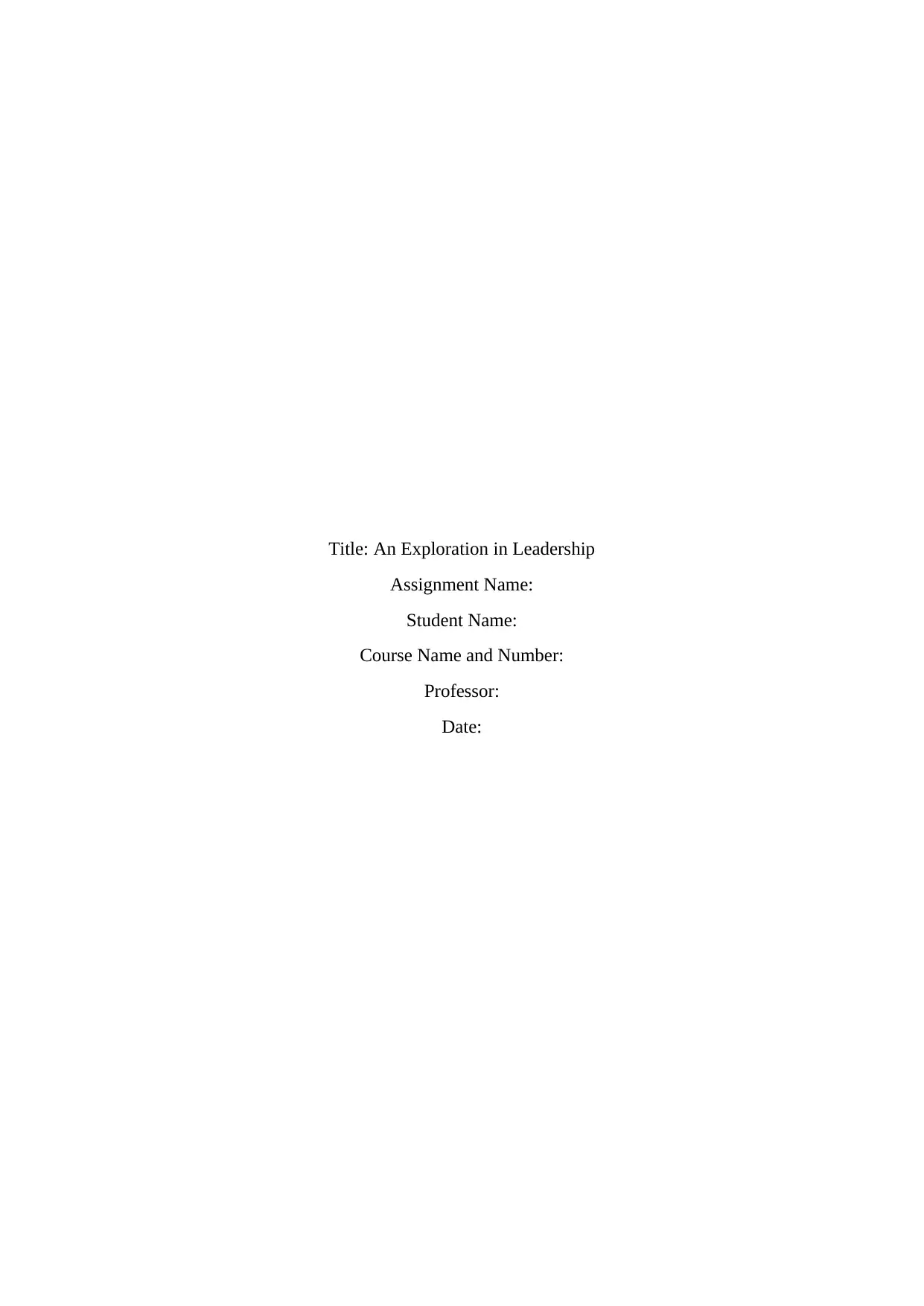
Title: An Exploration in Leadership
Assignment Name:
Student Name:
Course Name and Number:
Professor:
Date:
Assignment Name:
Student Name:
Course Name and Number:
Professor:
Date:
Paraphrase This Document
Need a fresh take? Get an instant paraphrase of this document with our AI Paraphraser
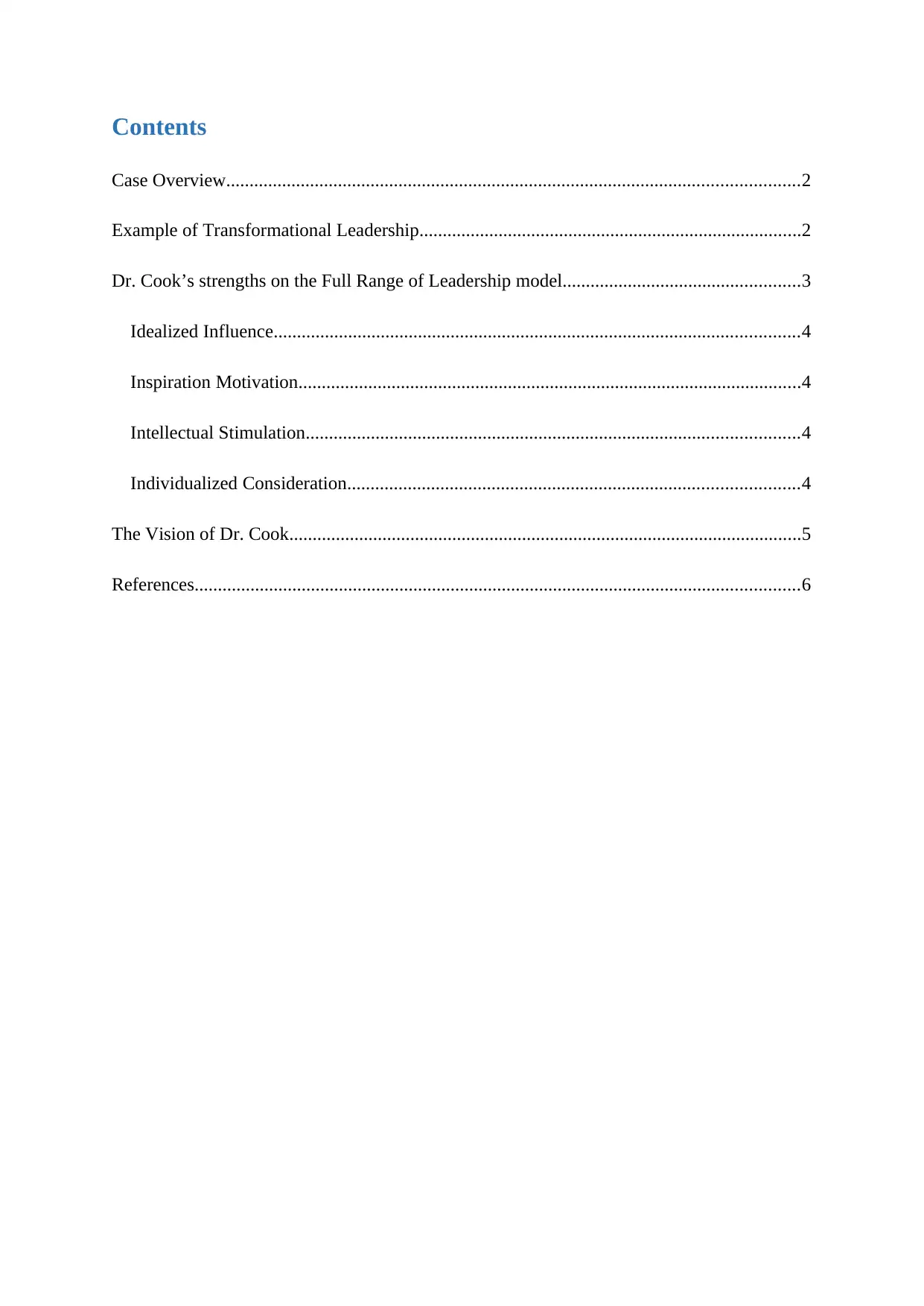
Contents
Case Overview...........................................................................................................................2
Example of Transformational Leadership..................................................................................2
Dr. Cook’s strengths on the Full Range of Leadership model...................................................3
Idealized Influence.................................................................................................................4
Inspiration Motivation............................................................................................................4
Intellectual Stimulation..........................................................................................................4
Individualized Consideration.................................................................................................4
The Vision of Dr. Cook..............................................................................................................5
References..................................................................................................................................6
Case Overview...........................................................................................................................2
Example of Transformational Leadership..................................................................................2
Dr. Cook’s strengths on the Full Range of Leadership model...................................................3
Idealized Influence.................................................................................................................4
Inspiration Motivation............................................................................................................4
Intellectual Stimulation..........................................................................................................4
Individualized Consideration.................................................................................................4
The Vision of Dr. Cook..............................................................................................................5
References..................................................................................................................................6
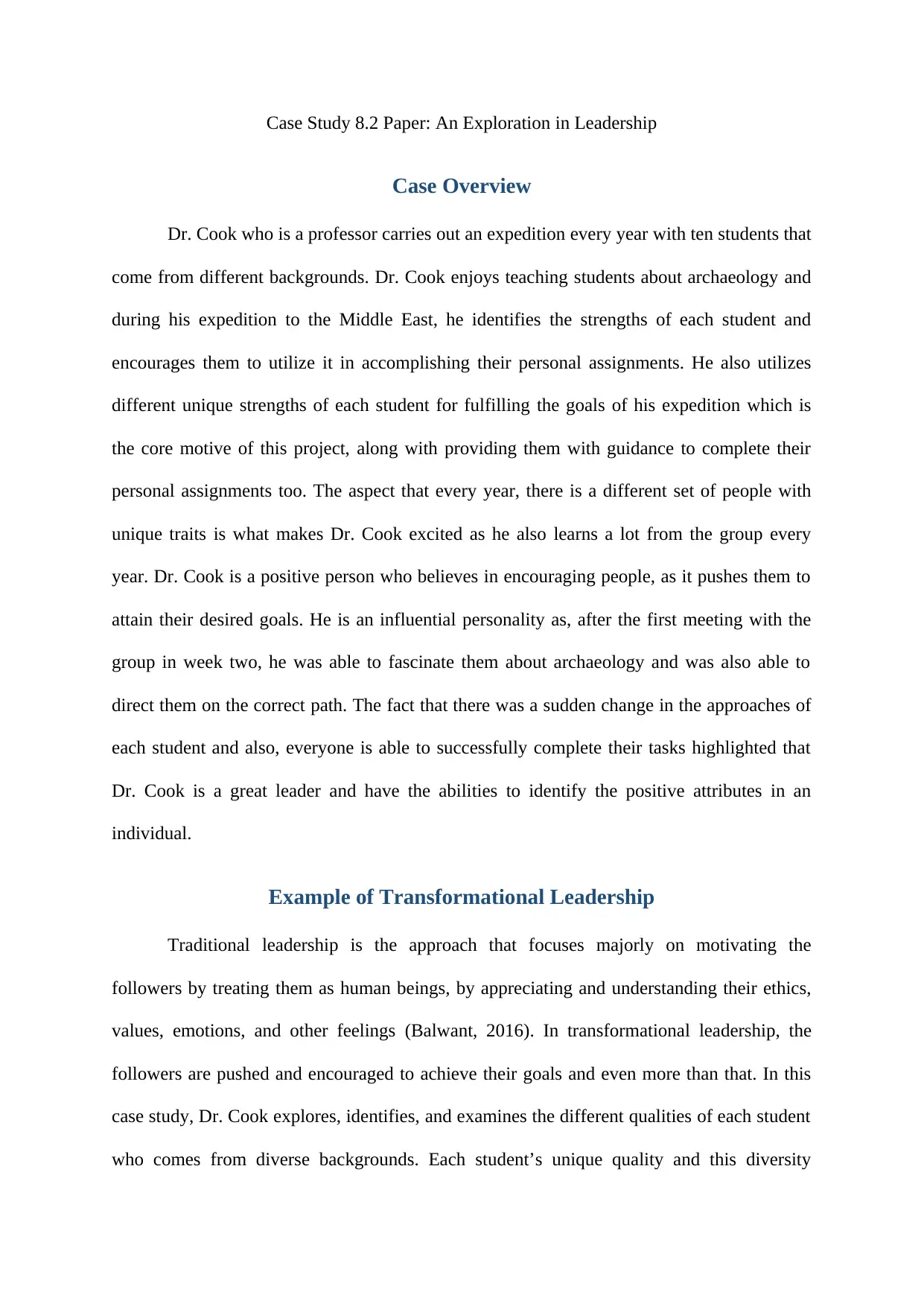
Case Study 8.2 Paper: An Exploration in Leadership
Case Overview
Dr. Cook who is a professor carries out an expedition every year with ten students that
come from different backgrounds. Dr. Cook enjoys teaching students about archaeology and
during his expedition to the Middle East, he identifies the strengths of each student and
encourages them to utilize it in accomplishing their personal assignments. He also utilizes
different unique strengths of each student for fulfilling the goals of his expedition which is
the core motive of this project, along with providing them with guidance to complete their
personal assignments too. The aspect that every year, there is a different set of people with
unique traits is what makes Dr. Cook excited as he also learns a lot from the group every
year. Dr. Cook is a positive person who believes in encouraging people, as it pushes them to
attain their desired goals. He is an influential personality as, after the first meeting with the
group in week two, he was able to fascinate them about archaeology and was also able to
direct them on the correct path. The fact that there was a sudden change in the approaches of
each student and also, everyone is able to successfully complete their tasks highlighted that
Dr. Cook is a great leader and have the abilities to identify the positive attributes in an
individual.
Example of Transformational Leadership
Traditional leadership is the approach that focuses majorly on motivating the
followers by treating them as human beings, by appreciating and understanding their ethics,
values, emotions, and other feelings (Balwant, 2016). In transformational leadership, the
followers are pushed and encouraged to achieve their goals and even more than that. In this
case study, Dr. Cook explores, identifies, and examines the different qualities of each student
who comes from diverse backgrounds. Each student’s unique quality and this diversity
Case Overview
Dr. Cook who is a professor carries out an expedition every year with ten students that
come from different backgrounds. Dr. Cook enjoys teaching students about archaeology and
during his expedition to the Middle East, he identifies the strengths of each student and
encourages them to utilize it in accomplishing their personal assignments. He also utilizes
different unique strengths of each student for fulfilling the goals of his expedition which is
the core motive of this project, along with providing them with guidance to complete their
personal assignments too. The aspect that every year, there is a different set of people with
unique traits is what makes Dr. Cook excited as he also learns a lot from the group every
year. Dr. Cook is a positive person who believes in encouraging people, as it pushes them to
attain their desired goals. He is an influential personality as, after the first meeting with the
group in week two, he was able to fascinate them about archaeology and was also able to
direct them on the correct path. The fact that there was a sudden change in the approaches of
each student and also, everyone is able to successfully complete their tasks highlighted that
Dr. Cook is a great leader and have the abilities to identify the positive attributes in an
individual.
Example of Transformational Leadership
Traditional leadership is the approach that focuses majorly on motivating the
followers by treating them as human beings, by appreciating and understanding their ethics,
values, emotions, and other feelings (Balwant, 2016). In transformational leadership, the
followers are pushed and encouraged to achieve their goals and even more than that. In this
case study, Dr. Cook explores, identifies, and examines the different qualities of each student
who comes from diverse backgrounds. Each student’s unique quality and this diversity
⊘ This is a preview!⊘
Do you want full access?
Subscribe today to unlock all pages.

Trusted by 1+ million students worldwide

completes the team and helps in achieving the desired goals. Dr. Cook listens to the students
patiently and understands their point of view. He then utilizes the students’ strengths along
with the available resources. He also provides the students with the opportunity to contribute
to the project by selecting particular tasks. This environment encouraged the students to
automatically divide the work amongst them, depending upon their strengths. Dr. Cook
facilitated the students with the freedom to freely design and schedule their work. But at the
same time, he also ensured that the students were also provided with the necessary help from
the seniors and the experts whenever needed. He openly shared his main objectives of the
project along with the other special interests. He shared his past experiences from his earlier
expeditions that motivated the students to perform beyond expectations. The transformation
in the group after the first meeting was immense as initially, the entire group was disjointed,
but later they developed a camaraderie to work together by supporting and motivating each
other. Dr. Cook was able to provide the students with a sense of achievement that
transformed them completely. He also had ten students returning from the previous year
(Hamad, 2015).
Strengths of Dr. Cook’s on the Full Range Leadership model
The full range leadership model facilitates the process of grouping different factors
that will determine the effectiveness, frequency, and degree of the three styles of
transactional leadership, non-leadership, and transformational leadership (Karakitapoğlu-
Aygün & Gumusluoglu, 2013). In the case study, Dr. Cook has exhibited all the aspects of
the transformational leadership. He utilized his influential attributes to influence and motivate
the students, to improve their timings and schedule and pushed them to achieve even more
than they desired. He increased the involvement of the students in the project by sharing the
main objectives of the project and also by informing the impact it will have in the field of
archaeology (Hein, 2014). The four I’s of transformational leadership are –
patiently and understands their point of view. He then utilizes the students’ strengths along
with the available resources. He also provides the students with the opportunity to contribute
to the project by selecting particular tasks. This environment encouraged the students to
automatically divide the work amongst them, depending upon their strengths. Dr. Cook
facilitated the students with the freedom to freely design and schedule their work. But at the
same time, he also ensured that the students were also provided with the necessary help from
the seniors and the experts whenever needed. He openly shared his main objectives of the
project along with the other special interests. He shared his past experiences from his earlier
expeditions that motivated the students to perform beyond expectations. The transformation
in the group after the first meeting was immense as initially, the entire group was disjointed,
but later they developed a camaraderie to work together by supporting and motivating each
other. Dr. Cook was able to provide the students with a sense of achievement that
transformed them completely. He also had ten students returning from the previous year
(Hamad, 2015).
Strengths of Dr. Cook’s on the Full Range Leadership model
The full range leadership model facilitates the process of grouping different factors
that will determine the effectiveness, frequency, and degree of the three styles of
transactional leadership, non-leadership, and transformational leadership (Karakitapoğlu-
Aygün & Gumusluoglu, 2013). In the case study, Dr. Cook has exhibited all the aspects of
the transformational leadership. He utilized his influential attributes to influence and motivate
the students, to improve their timings and schedule and pushed them to achieve even more
than they desired. He increased the involvement of the students in the project by sharing the
main objectives of the project and also by informing the impact it will have in the field of
archaeology (Hein, 2014). The four I’s of transformational leadership are –
Paraphrase This Document
Need a fresh take? Get an instant paraphrase of this document with our AI Paraphraser
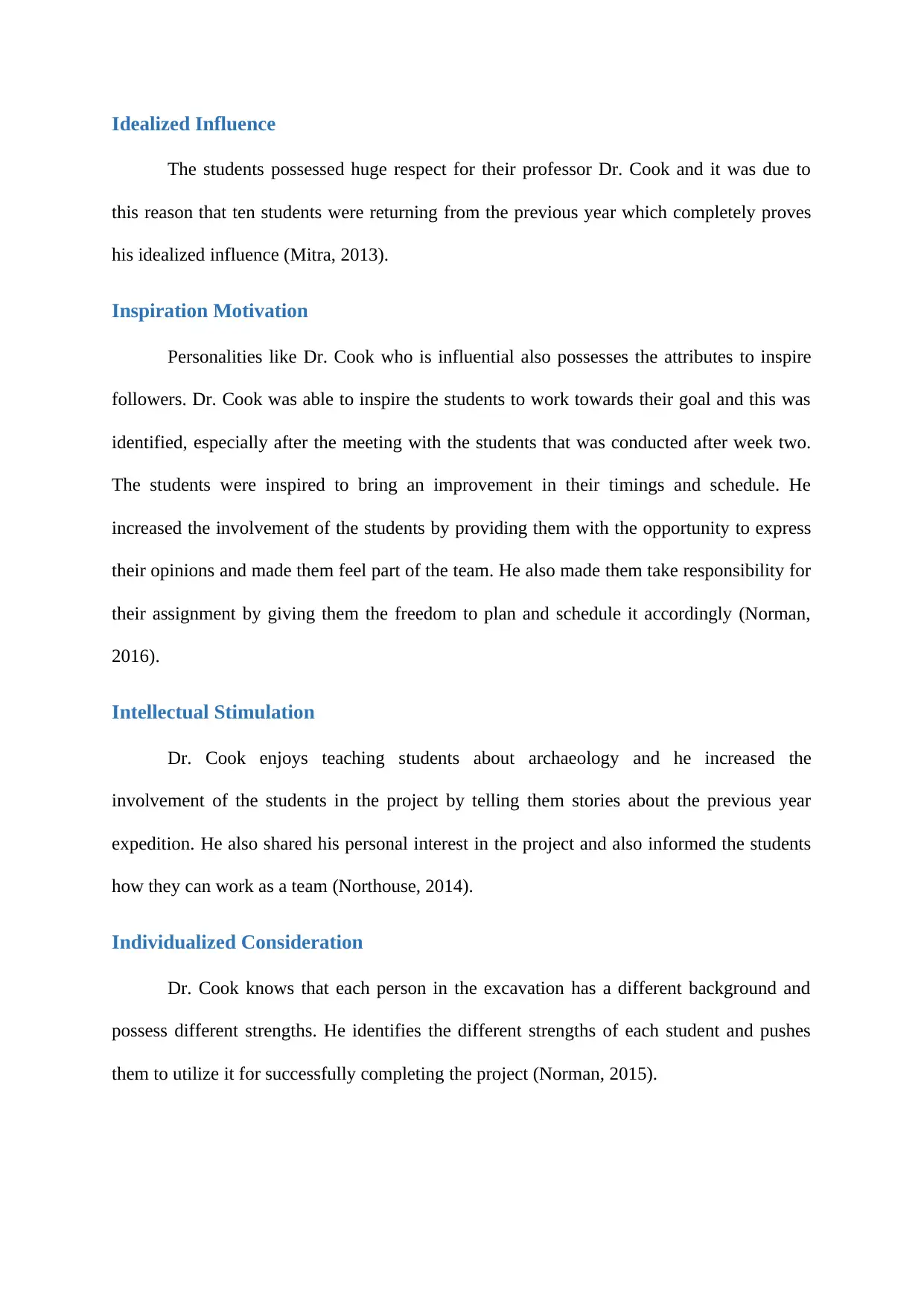
Idealized Influence
The students possessed huge respect for their professor Dr. Cook and it was due to
this reason that ten students were returning from the previous year which completely proves
his idealized influence (Mitra, 2013).
Inspiration Motivation
Personalities like Dr. Cook who is influential also possesses the attributes to inspire
followers. Dr. Cook was able to inspire the students to work towards their goal and this was
identified, especially after the meeting with the students that was conducted after week two.
The students were inspired to bring an improvement in their timings and schedule. He
increased the involvement of the students by providing them with the opportunity to express
their opinions and made them feel part of the team. He also made them take responsibility for
their assignment by giving them the freedom to plan and schedule it accordingly (Norman,
2016).
Intellectual Stimulation
Dr. Cook enjoys teaching students about archaeology and he increased the
involvement of the students in the project by telling them stories about the previous year
expedition. He also shared his personal interest in the project and also informed the students
how they can work as a team (Northouse, 2014).
Individualized Consideration
Dr. Cook knows that each person in the excavation has a different background and
possess different strengths. He identifies the different strengths of each student and pushes
them to utilize it for successfully completing the project (Norman, 2015).
The students possessed huge respect for their professor Dr. Cook and it was due to
this reason that ten students were returning from the previous year which completely proves
his idealized influence (Mitra, 2013).
Inspiration Motivation
Personalities like Dr. Cook who is influential also possesses the attributes to inspire
followers. Dr. Cook was able to inspire the students to work towards their goal and this was
identified, especially after the meeting with the students that was conducted after week two.
The students were inspired to bring an improvement in their timings and schedule. He
increased the involvement of the students by providing them with the opportunity to express
their opinions and made them feel part of the team. He also made them take responsibility for
their assignment by giving them the freedom to plan and schedule it accordingly (Norman,
2016).
Intellectual Stimulation
Dr. Cook enjoys teaching students about archaeology and he increased the
involvement of the students in the project by telling them stories about the previous year
expedition. He also shared his personal interest in the project and also informed the students
how they can work as a team (Northouse, 2014).
Individualized Consideration
Dr. Cook knows that each person in the excavation has a different background and
possess different strengths. He identifies the different strengths of each student and pushes
them to utilize it for successfully completing the project (Norman, 2015).
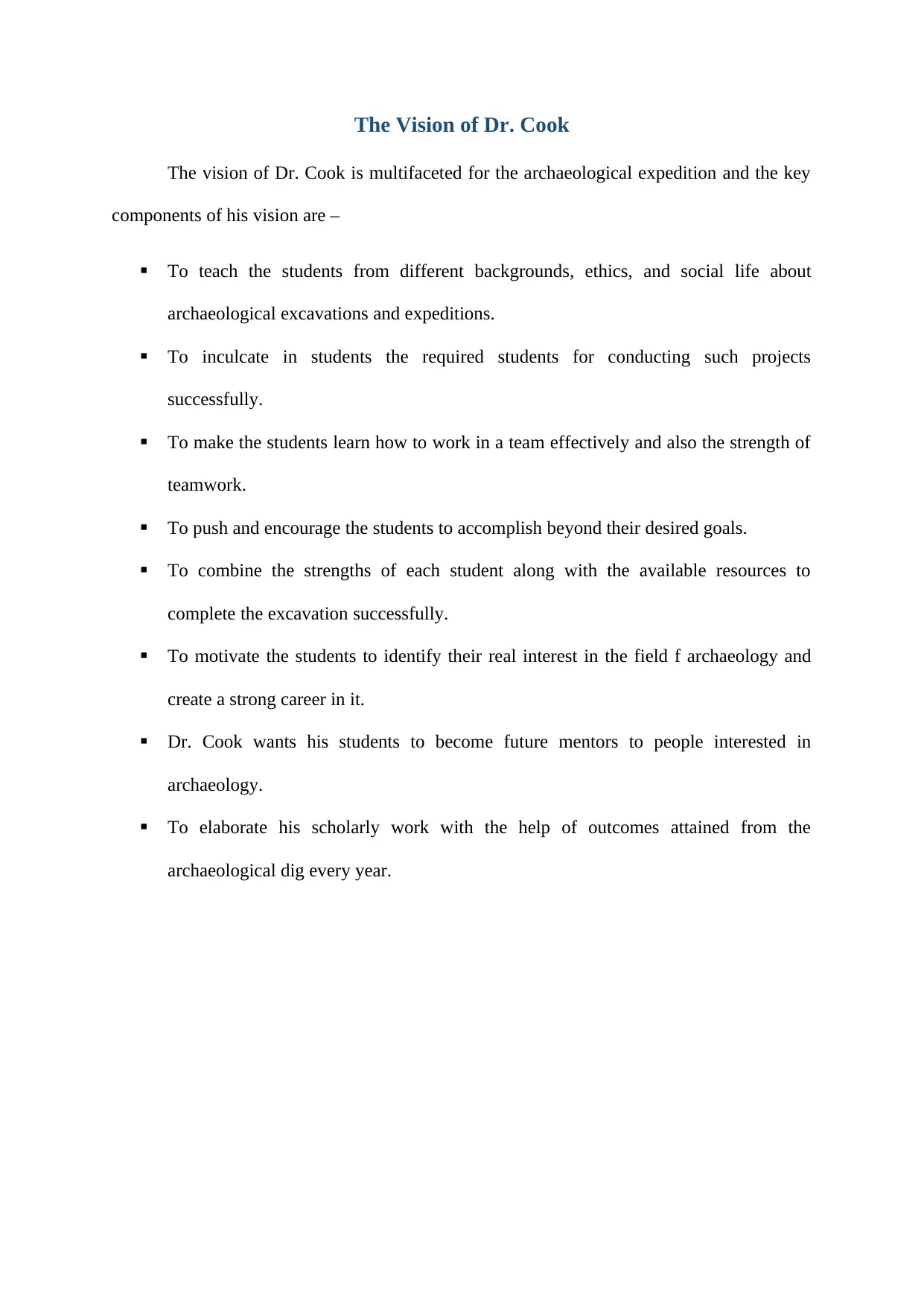
The Vision of Dr. Cook
The vision of Dr. Cook is multifaceted for the archaeological expedition and the key
components of his vision are –
To teach the students from different backgrounds, ethics, and social life about
archaeological excavations and expeditions.
To inculcate in students the required students for conducting such projects
successfully.
To make the students learn how to work in a team effectively and also the strength of
teamwork.
To push and encourage the students to accomplish beyond their desired goals.
To combine the strengths of each student along with the available resources to
complete the excavation successfully.
To motivate the students to identify their real interest in the field f archaeology and
create a strong career in it.
Dr. Cook wants his students to become future mentors to people interested in
archaeology.
To elaborate his scholarly work with the help of outcomes attained from the
archaeological dig every year.
The vision of Dr. Cook is multifaceted for the archaeological expedition and the key
components of his vision are –
To teach the students from different backgrounds, ethics, and social life about
archaeological excavations and expeditions.
To inculcate in students the required students for conducting such projects
successfully.
To make the students learn how to work in a team effectively and also the strength of
teamwork.
To push and encourage the students to accomplish beyond their desired goals.
To combine the strengths of each student along with the available resources to
complete the excavation successfully.
To motivate the students to identify their real interest in the field f archaeology and
create a strong career in it.
Dr. Cook wants his students to become future mentors to people interested in
archaeology.
To elaborate his scholarly work with the help of outcomes attained from the
archaeological dig every year.
⊘ This is a preview!⊘
Do you want full access?
Subscribe today to unlock all pages.

Trusted by 1+ million students worldwide
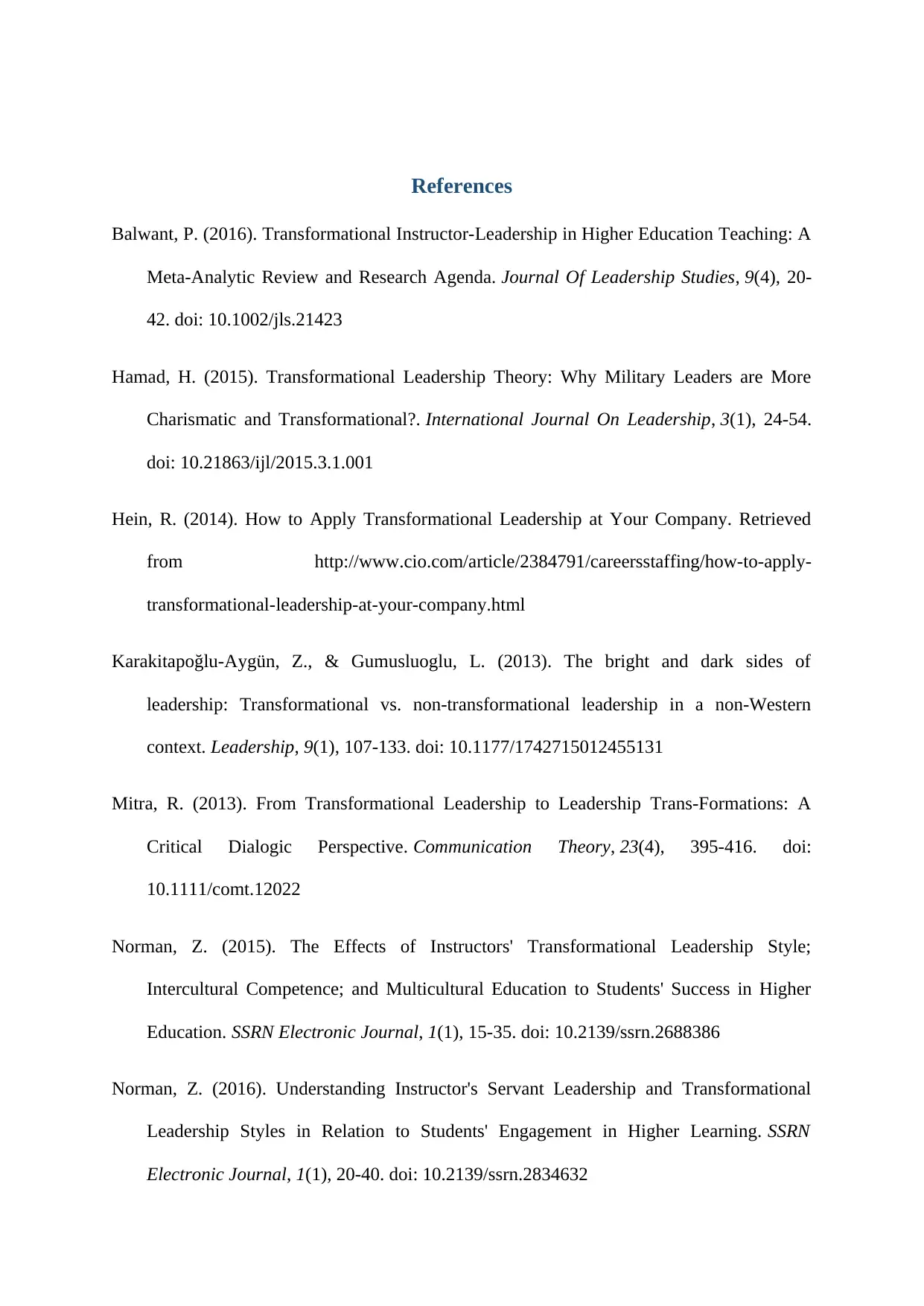
References
Balwant, P. (2016). Transformational Instructor-Leadership in Higher Education Teaching: A
Meta-Analytic Review and Research Agenda. Journal Of Leadership Studies, 9(4), 20-
42. doi: 10.1002/jls.21423
Hamad, H. (2015). Transformational Leadership Theory: Why Military Leaders are More
Charismatic and Transformational?. International Journal On Leadership, 3(1), 24-54.
doi: 10.21863/ijl/2015.3.1.001
Hein, R. (2014). How to Apply Transformational Leadership at Your Company. Retrieved
from http://www.cio.com/article/2384791/careersstaffing/how-to-apply-
transformational-leadership-at-your-company.html
Karakitapoğlu-Aygün, Z., & Gumusluoglu, L. (2013). The bright and dark sides of
leadership: Transformational vs. non-transformational leadership in a non-Western
context. Leadership, 9(1), 107-133. doi: 10.1177/1742715012455131
Mitra, R. (2013). From Transformational Leadership to Leadership Trans-Formations: A
Critical Dialogic Perspective. Communication Theory, 23(4), 395-416. doi:
10.1111/comt.12022
Norman, Z. (2015). The Effects of Instructors' Transformational Leadership Style;
Intercultural Competence; and Multicultural Education to Students' Success in Higher
Education. SSRN Electronic Journal, 1(1), 15-35. doi: 10.2139/ssrn.2688386
Norman, Z. (2016). Understanding Instructor's Servant Leadership and Transformational
Leadership Styles in Relation to Students' Engagement in Higher Learning. SSRN
Electronic Journal, 1(1), 20-40. doi: 10.2139/ssrn.2834632
Balwant, P. (2016). Transformational Instructor-Leadership in Higher Education Teaching: A
Meta-Analytic Review and Research Agenda. Journal Of Leadership Studies, 9(4), 20-
42. doi: 10.1002/jls.21423
Hamad, H. (2015). Transformational Leadership Theory: Why Military Leaders are More
Charismatic and Transformational?. International Journal On Leadership, 3(1), 24-54.
doi: 10.21863/ijl/2015.3.1.001
Hein, R. (2014). How to Apply Transformational Leadership at Your Company. Retrieved
from http://www.cio.com/article/2384791/careersstaffing/how-to-apply-
transformational-leadership-at-your-company.html
Karakitapoğlu-Aygün, Z., & Gumusluoglu, L. (2013). The bright and dark sides of
leadership: Transformational vs. non-transformational leadership in a non-Western
context. Leadership, 9(1), 107-133. doi: 10.1177/1742715012455131
Mitra, R. (2013). From Transformational Leadership to Leadership Trans-Formations: A
Critical Dialogic Perspective. Communication Theory, 23(4), 395-416. doi:
10.1111/comt.12022
Norman, Z. (2015). The Effects of Instructors' Transformational Leadership Style;
Intercultural Competence; and Multicultural Education to Students' Success in Higher
Education. SSRN Electronic Journal, 1(1), 15-35. doi: 10.2139/ssrn.2688386
Norman, Z. (2016). Understanding Instructor's Servant Leadership and Transformational
Leadership Styles in Relation to Students' Engagement in Higher Learning. SSRN
Electronic Journal, 1(1), 20-40. doi: 10.2139/ssrn.2834632
Paraphrase This Document
Need a fresh take? Get an instant paraphrase of this document with our AI Paraphraser

Northouse. (2014). Leadership: theory and practice (6th ed., pp. 30-60). Michigan: Sage
Publications.
Publications.
1 out of 8
Related Documents
Your All-in-One AI-Powered Toolkit for Academic Success.
+13062052269
info@desklib.com
Available 24*7 on WhatsApp / Email
![[object Object]](/_next/static/media/star-bottom.7253800d.svg)
Unlock your academic potential
Copyright © 2020–2025 A2Z Services. All Rights Reserved. Developed and managed by ZUCOL.





